Quite often in yoga it’s not the tricky poses that trip us up, but the ones that look deceptively simple. Whether because we assume we’re doing it right, or we simply let our ego get the better of us. This is one of the reasons I started the yoga tutorials videos. Today I want to discuss how to do anjaneyasana, or low lunge.

While these basic pose tutorials are aimed at beginners, they are really for all levels. In the tutorial we’ll go step-by-step through the pose. Plus some common mistakes and their fixes.
If you can’t view the embedded video above, you can view the video on YouTube. Maybe add it to a playlist? Above all, remember to subscribe to my channel. New videos are uploaded every Tuesday and Friday. However, for exclusive longer format videos sign up for my Patreon community. Patrons also get early access to all my videos, along with lots of other benefits.
How to do anjaneyasana
Typically, anjaneyasana is transitioned through from 3-legged dog pose, by stepping the lifted leg between the hands and into the low lunge. This can be a tricky transition for many, and in a previous post I’ve covered the reasons why and how to make it a little more seamless. So from downward-facing dog, lift the right leg up.
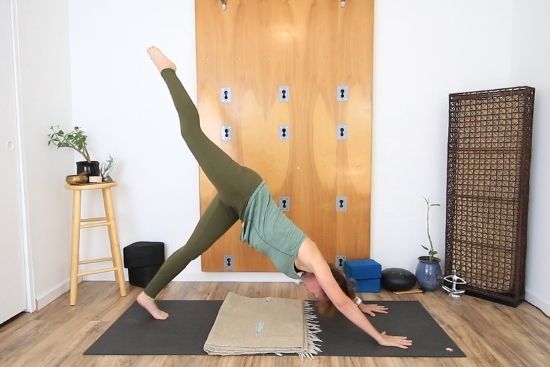
Drawn the navel to the spine, push through the hands and bend the knee. Step the right foot through between the hands. Drop the left knee to the floor, and untuck the toes. With the right knee stacked above the ankle let the torso rise, and lift the arms overhead.
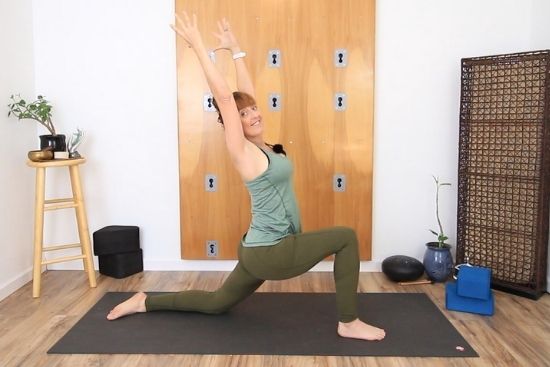
The most common error in this pose is mostly in the very flexible people who ‘hang’ in the hips. Again, say hello to the ego that thinks “feeling” something, or anything, in the hips is the goal.
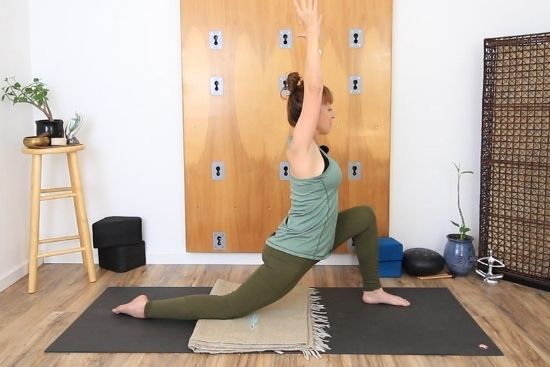
Instead, energize the front leg by pushing down into the front foot, allowing the back thigh to lift a little and energize. You can also draw your focus to the back knee and shin, and consciously try and connect more of the shin to the floor. This is a pose of energy, and openness. Not sinking and hanging.

If you have an issue with pain associated with having the back knee on the floor then provide some support. So many times I’ve suggested blankets or foam pads in your yoga practice. If, like me, your knees are on the boney side then provide some padding!
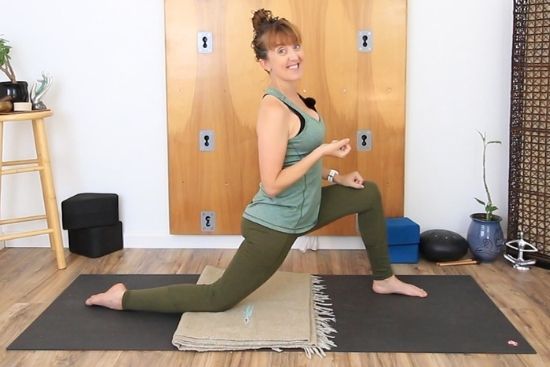
Finally, let’s talk about the arms. While the arms traditionally reach up, they don’t have to. I’ll repeat that, they don’t have to. Do what’s right for your shoulders. Maybe that’s hands at the head, heart or hips. Or choosing some other arm position that works for your body.
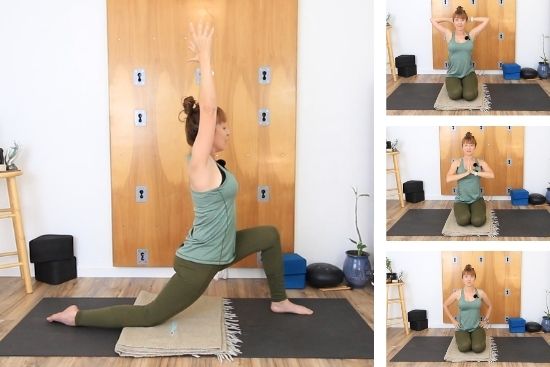
Above all, energize, be comfortable, and do what feels right for your body. I’m fond of throwing traditional alignment cues out the window and instead creating a variation that is optimal for you. Yoga isn’t about just getting flexible. It’s strength, balance, body awareness, breath, focus, and so much more. The poses are the tip of the iceberg.
Want more yoga?
If you’re looking for real yoga for real bodies, consider joining my Patreon. Each month I release two yoga classes exclusively for my Patreon community. Other ways to find more yoga with me are signing up for my 7-day yoga challenge, or subscribing to my YouTube channel.
Questions
- Have you tried anjaneyasana/low lunge?
- What struggles do you have with this pose?
- Do you experience pain or sensitivity in the knees?
 Somatic Yoga for tight lats & IT band
Somatic Yoga for tight lats & IT band
Clarice
This is really helpful. I did not really the mistakes I am making and thank you for the tips on how to fix them. Appreciate the video as well. Makes it easy to follow.
Di Hickman
Thank you! Glad the video helped! Which mistakes were you making?
Nkem
I have knee sensitivity in my right knee, so I tend to need a blanket or something. Thanks for this tutorial!
Di Hickman
I rarely do this without padding. My knees suck lol!
Nisha
Anjaneyasana or low lunge seems like a great yoga pose to stretch the hips and legs, yes the backleg having a padding will also help .Good one!
Di Hickman
Oh I always do it with some padding! lol!
Alvern
That pose looks interesting. I guess the bottomline is that it is doing some good to the body and mind as well as keeping you flexible.
Di Hickman
100%
Lyosha
I love this pose! It helps we with running a lot. I love your tips, it will definitely help to improve the pose
Di Hickman
yes it really does help with running/cycling. One reason it’s in essential for my personal practice
Bethan Taylor-Swaine
This is one of my favourite poses! I love how it opens my hips and my chest – both places where I tend to hold a lot of tension (physical and emotional!) – and challenges my balance, something I always need to work on.
Di Hickman
me too! My hip flexors are tight.
Viano
I haven’t heard about this pose let alone tried it. You make it seem easy though.
Di Hickman
One of my favorites, because I have tight hip flexors. So this is a struggle and I have to warm up a lot for it
Michael
Having a video inside this post is helpful. Great job. A full experience. It makes it easier for everyone to do it too
Di Hickman
Thanks. Yes, if a photo tells a thousand words, then a video tells a million I think.